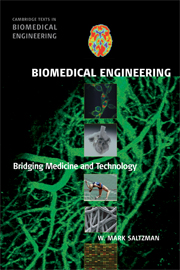Book contents
- Frontmatter
- Contents
- Preface
- Acknowledgments
- Abbreviations and Acronyms
- 1 Introduction: What Is Biomedical Engineering?
- PART 1 MOLECULAR AND CELLULAR PRINCIPLES
- 2 Biomolecular Principles
- 3 Biomolecular Principles: Nucleic Acids
- 4 Biomolecular Principles: Proteins
- 5 Cellular Principles
- PART 2 PHYSIOLOGICAL PRINCIPLES
- PART 3 BIOMEDICAL ENGINEERING
- Appendix A Physiological Parameters
- Appendix B Chemical Parameters
- Appendix C Units and Conversion Factors
- Index
- Plate section
- References
5 - Cellular Principles
from PART 1 - MOLECULAR AND CELLULAR PRINCIPLES
- Frontmatter
- Contents
- Preface
- Acknowledgments
- Abbreviations and Acronyms
- 1 Introduction: What Is Biomedical Engineering?
- PART 1 MOLECULAR AND CELLULAR PRINCIPLES
- 2 Biomolecular Principles
- 3 Biomolecular Principles: Nucleic Acids
- 4 Biomolecular Principles: Proteins
- 5 Cellular Principles
- PART 2 PHYSIOLOGICAL PRINCIPLES
- PART 3 BIOMEDICAL ENGINEERING
- Appendix A Physiological Parameters
- Appendix B Chemical Parameters
- Appendix C Units and Conversion Factors
- Index
- Plate section
- References
Summary
LEARNING OBJECTIVES
After reading this chapter, you should:
Understand the basic components of eukaryotic cells and the differences between eukaryotic and prokaryotic cells.
Understand the basic role of the cytoskeleton, ribosomes, endoplasmic reticulum (ER), Golgi apparatus, mitochondria, lysosomes, and genomic deoxyribonucleic acid (DNA) in cell function.
Understand the structure of extracellular matrix (ECM) and its role in tissue function.
Understand the role of membrane proteins in regulating transport through cell membranes and regulating cell adhesion.
Understand the cell cycle and cell division by mitosis and meiosis.
Understand the basic principles of stem cells and differentiation.
Understand the basic elements of cell culture and its importance in modern biomedical science and engineering.
Prelude
The cell is the basic functional unit in the body. The human body is composed of more than 200 different types of cells (Figure 5.1). Each cell of an individual is genetically the same: They all share the same genetic information, but cell types within an individual differ with respect to size, shape, and constituent molecules (Figure 5.2); therefore, they have different properties. For example, liver cells have abundant enzymes for detoxification of chemicals whereas red blood cells instead have abundant hemoglobin for oxygen transport. These differences are important to the function of the cell in the context of the organ in which it resides.
Despite this diversity of cell composition and function, the trillions of cells in each person (most estimates range from 50 to 200 trillion cells in an average person) share common properties.
- Type
- Chapter
- Information
- Biomedical EngineeringBridging Medicine and Technology, pp. 168 - 202Publisher: Cambridge University PressPrint publication year: 2009
References
- 1
- Cited by

